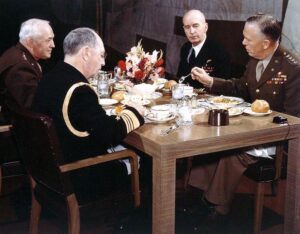by Christopher D. Holmes
Disclaimer: The views and opinions expressed in this article are those of the author and not necessarily those of the Department of Defense or the Joint Chiefs of Staff.
An invitation to lunch is a delightful way to share a meal with a colleague or friend. Besides nourishment, it also provides a way of fostering the relationship. For strategic level leaders, this is a crucial mechanism since relationships form the cornerstone of such leadership. So important are relationships to strategic leadership that the U.S. Army manual describes a primary task for strategic leaders as “build[ing] and shap[ing] relationships.” One can see this aspect in the way General of the Army George C. Marshall used lunches with his American military peers, British counterparts, and civilian leaders as an informal, yet powerful, way of building and maintaining relationships during World War II.
Joint Chiefs of Staff
One of the most notable ways Marshall utilized lunches was with his colleagues on the Joint Chiefs of Staff. Established at the end of the Arcadia Conference in Washington, D.C., on January 14, 1942, the Joint Chiefs of Staff initially consisted of Marshall as chief of staff of the Army, Lieutenant General Henry H. Arnold as chief of the Army Air Forces, and Admiral Harold R. Stark as chief of naval operations. Later that year, Admiral Ernest J. King replaced Admiral Stark, and Admiral William D. Leahy joined as the chief of staff to the commander in chief Shortly after Arcadia’s conclusion, the Joint Chiefs began meeting weekly to coordinate their services’ efforts and set the overall strategic direction of the war.
By July 1942, these formal meetings were held every Tuesday, a schedule that continued until the end of the war. Prior to these sessions, the Joint Chiefs held “working lunches,” a practice that also continued throughout the war. While Marshall undoubtedly knew the other chiefs well, he used these lunches as a way of nurturing his relationships with them. More importantly, these lunches provided a forum for Marshall to reconcile differing viewpoints more openly and frankly, as no other staff officers were present. In fact, a 1943 article in the New York Times noted how seemingly effective these lunch meetings were at fostering compromises.
As an example, on November 14, 1944, Marshall wrote Assistant Secretary of War John J. McCloy about such a meeting, in which where he worked to gain consensus amongst the Joint Chiefs. In this summary, Marshall indicated that at their luncheon that day, the Joint Chiefs debated and reached agreement on the necessity of creating a group to coordinate military efforts with those in the diplomatic arena as well as the structure and role of such a group. Comprised of the secretaries of war, navy, and state, this group would formally coordinate with the Joint Chiefs to determine the “military implications” of political objectives with a goal of harmonizing the two.
Marshall long harbored a belief in the importance of such coordination, saying that “political strategy must always have in the background military fundamentals or capabilities.” What the Joint Chiefs proposed after their lunch on that November day resulted in the formal creation of the State-War-Navy Coordinating Committee that, in the minutes of its first meeting on December 19, 1944, incorporated the Joint Chiefs proposed language into its charter.
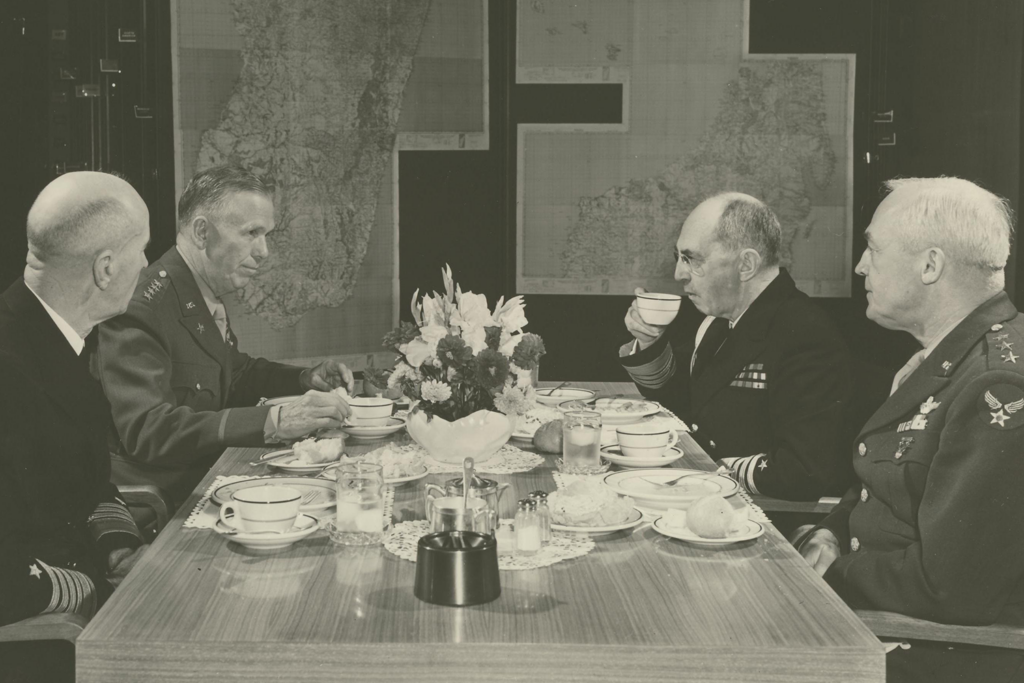
Admiral King, Gen. Marshall, Admiral Leahy and General Arnold at one of the weekly luncheons in the Presentation Room, Combined Chiefs of Staff Building, November 3, 1942. GCMF photo.
Marshall also used one-on-one lunches with colleagues to defuse tensions and work through issues. For example, Marshall met Admiral King on June 30, 1942, at lunch to talk through his reservations about King’s proposed command arrangements in the Southwest Pacific. King believed that Admiral Chester W. Nimitz should command the forthcoming offensive in the Solomon Islands because naval and Marine forces constituted the task force. But Marshall believed General Douglas MacArthur, an Army officer, should command instead because the objective’s geographic location fell within his area of responsibility. Their lunchtime conversation preceded further discussion of the issue at the Joint Chiefs of Staff meeting the following day, where King and Marshall outlined the compromise solution of Nimitz commanding the task force for the first phase (called “task”) of the operation, and MacArthur commanding the subsequent tasks. Marshall’s success lay in using such luncheons to keep channels of dialogue open and planning moving along.
Sir John Dill and the British Joint Staff Mission
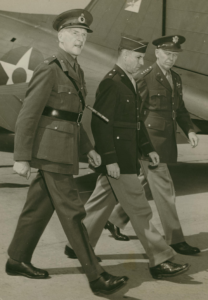
Gen. Marshall and Marshal Sir John Dill of the British Forces are met by General Loven Allen, Commandant of the Infantry School, Ft. Benning. April 30, 1942 (GCMF photo)
Marshall also used lunches to foster good relations with his British counterparts, and Field Marshal Sir John Dill in particular. General Marshall first encountered Dill in August 1941 during the conference between President Franklin D. Roosevelt and British Prime Minister Winton Churchill, held aboard USS Augusta in Placentia Bay, Newfoundland. Shortly after Churchill and Roosevelt exchanged formal greetings upon first meeting each other, their accompanying military staffs adjourned for separate meetings over lunch. It was at this “very good, fork” [i.e. buffet] lunch that Marshall officially met his British Army counterpart, Sir John Dill. In an informal setting, Marshall and Dill became acquainted, discovering how well they got along.
They next met four months later during the Arcadia Conference. On the last day, Marshall, Dill, the American Joint Chiefs, and their British counterparts all met for what was later described as an “excellent” but “simple” luncheon in the executive dining room at the Federal Reserve’s Board of Governors building on Constitution Avenue. In the few photographs taken of the event, one can see General Marshall chatting amiably with First Sea Lord Admiral Sir Dudley Pound , as well as Admiral Stark and Field Marshal Dill. This more informal tone, sharing a meal with business coming secondary to fellowship, was one observed for the remainder of the war at Combined Chiefs lunches.
When the British chiefs of staff returned to the United Kingdom in late January 1942, Field Marshal Dill and several other senior military officers stayed behind to serve as their representatives in Washington, forming what became known as the Joint Staff Mission, led by Dill. He and his team met weekly with their American counterparts, mirroring the American Joint Staff. Just like he did with his American colleagues, Marshall held a lunch with Dill prior to each of these meetings to informally “settle or diffuse” any ensuing issue. This informal gathering helped nurture the relationships that later proved crucial to these officers’ collaboration on the strategic direction of the war. Moreover, the personal connections and understandings developed at this sort of gathering provided a bedrock that allowed these senior officers to work their way through the often-profound disagreements over strategy that later emerged.
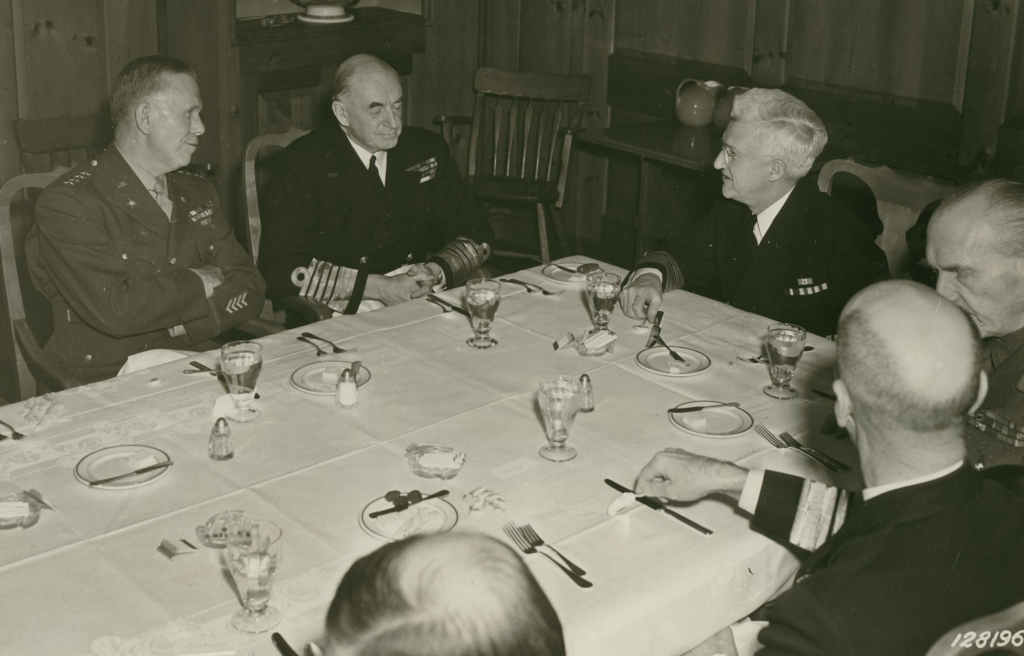
Lunch on the last day of the Arcadia Conference, 14 January 1942,, with (left to right) U,S. Army Chief of Staff General George C. Marshall, British First Sea Lord Sir Dudley Pound, U.S. Chief of Naval Operations Admiral Harold R. Stark, Field Marshal Sir John Dill, Commander in Chief U.S. Fleet Admiral Ernest J. King (back to camera) (GCMF photo)
For instance, Marshall wrote President Roosevelt on February 20, 1943, that Field Marshal Dill successfully leveraged their friendship and personal relationships he had established with his other British and American colleagues to avoid “a complete stalemate” at the Casablanca Conference over seemingly intractable disagreements about the weight of effort to fight Germany versus Japan. Later, after Dill’s death in November 1944, Marshall’s remarks revealed the depth of the friendship that developed, in part, because of these lunches: “I personally have lost a dear friend, unique in my lifetime and never to be out of my mind.”
Civilian Peers
Marshall also found the luncheon approach helpful when dealing with his civilian counterparts, especially Harry Hopkins, special advisor to President Roosevelt. For instance, on March 10, 1941, Marshall shared lunch with Hopkins to review what materiel should be shipped to Great Britain as part of the Lend-Lease agreement. Hopkins provided Marshall the list of British requests that Marshall subsequently worked to fulfill. Though Marshall admitted that such lunches occurred less frequently after the US formally entered the war, they still took place. He and Hopkins lunched on September 28, 1943, to both socialize and prepare for a meeting with President Roosevelt later that same day to explain the problems with aerial supply missions from India to China.
Roosevelt believed those problems hampered the Nationalist Chinese ability to combat Japanese forces and, based on the presentation from Marshall and Hopkins, urged the two to correct the problems. Marshall’s letter to Hopkins’ fiancée on July 3, 1942, reveals how well these lunches contributed to their friendship, since Marshall described him as “gallant and self-sacrificing to an extreme, little of which is realized by any but his most intimate friends.” Marshall later wrote Hopkins to express the importance of their relationship, saying “You personally have been of invaluable service to me in the discharge of my duties in this war.”
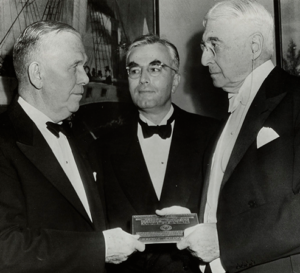
Secretary of State Marshall receives the annual Freedom Award from Bernard Baruch as Dr. Harry Gideonse looks on, October 19, 1947 (GCMF photo).
Another civilian peer was Bernard Baruch, a special advisor to President Roosevelt. Marshall often sought Baruch’s counsel, particularly on issues related to industrial and personnel mobilization given his role in those areas during World War I. In July 1939, while was serving as deputy chief of staff of the Army, Marshall wrote Baruch asking him for the opportunity to meet over lunch to discuss several topics related to mobilization. After becoming chief of staff, Marshall sought Baruch’s advice on confronting resistance to proposed draft measures on the eve of the formal American entry into the war. These are but two examples of Marshall using lunches as a technique to cultivate their relationship, setting the foundation for what Baruch would later characterize as a “warm friend[ship].”
Conclusion
By meeting over lunch, not only did Marshall create an informal environment, but he also signaled his desire to foster personal relationships, something that in turn promoted continued collaboration. While there indeed were disagreements, some quite heated particularly amongst the Joint and Combined Chiefs, Marshall used lunches as a technique to maintain favorable relations with all of his colleagues and keep channels of dialogue open. In so doing, he exemplified a key tenet of strategic leadership, and illustrated how that tenet aided him in steering American strategic military policy during World War II.
Col. Christopher D. Holmes (USAF, Ret.) is a historian on the Joint Staff.

